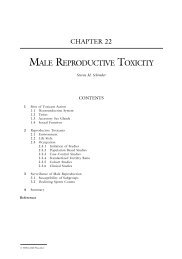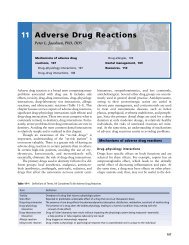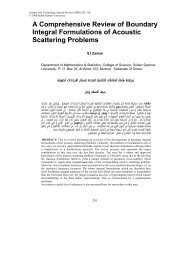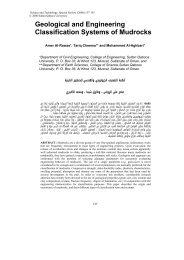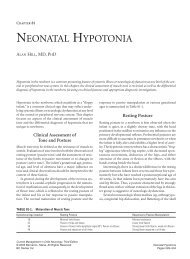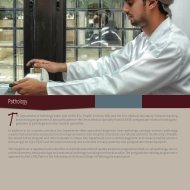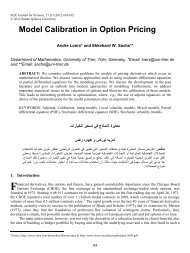(Solanum Tuberosum L.) grown in Oman - Sultan Qaboos University
(Solanum Tuberosum L.) grown in Oman - Sultan Qaboos University
(Solanum Tuberosum L.) grown in Oman - Sultan Qaboos University
Create successful ePaper yourself
Turn your PDF publications into a flip-book with our unique Google optimized e-Paper software.
Science and Technology, 8 (2003) 83-95<br />
© 2003 <strong>Sultan</strong> <strong>Qaboos</strong> <strong>University</strong><br />
Effect of Mechanical Injury and Low Temperature<br />
Storage on the Accumulation of Glycoalkaloids<br />
<strong>in</strong> the Tubers of 7 Varieties of Potato (<strong>Solanum</strong><br />
<strong>Tuberosum</strong> L.) <strong>grown</strong> <strong>in</strong> <strong>Oman</strong><br />
Elsadig A. Eltayeb*, Sana Salem Al-S<strong>in</strong>ani* and I. A. Khan**<br />
*Department of Biology, College of Science, <strong>Sultan</strong> <strong>Qaboos</strong> <strong>University</strong>, P.O.Box 36,<br />
Al Khod 123, Muscat, <strong>Sultan</strong>ate of <strong>Oman</strong>; Email: eatayeb@squ.edu.om,<br />
**Department of Crop Science, College of Agriculture, <strong>Sultan</strong> <strong>Qaboos</strong> <strong>University</strong>.<br />
تﺎﻧرد ﻲﻓ ﺔﻳﺮﻜﺴﻟا تاﺪﻳﻮﻟﺎﻜﻟﻷا ﻢآاﺮﺗ ﻰﻠﻋ ﺔﻀﻔﺨﻨﻣ ةراﺮﺣ تﺎﺟرد ﻲﻓ ﺎﻬﻨﻳﺰﺨﺗو ﺲﻃﺎﻄﺒﻟا تﺎﻧرد تﺎﺑﺎﺻإو حوﺮﺟ ﺮﻴﺛﺄﺗ<br />
نﺎﻤﻋ ﺔﻨﻄﻠﺱ ﻲﻓ عرﺰﺗ ﻲﺘﻟا ﺲﻃﺎﻄﺒﻟا ﻦﻣ عاﻮﻧأ 7<br />
نﺎﺥ راﺮﻗإو ﻲﻧﺎﻨﺴﻟا ﻢﻟﺎﺱ ءﺎﻨﺱ ، ﺐﻴﻄﻟا ﷲاﺪﺒﻋ قدﺎﺼﻟا<br />
ﺖ�ﺤﺗ ﻦﻳﺰ�ﺨﺘﻟا ﻞ�ﺜﻡ ﺔ�ﻴﺌﻴﺒﻟا تاﺮﻴﺛﺄ�ﺘﻟا ﺾﻌﺒ�ﻟ ﺔﺠﻴﺘﻨآ ﺲﻃﺎﻄﺒﻟا تﺎﻥرد ﻲﻓ تاﺪﻳﻮﻟﺎﻜﻟﻷا ﻢآاﺮﺗو ﺔﻋﺎﻨﺻ ﺔﺳارد ﺖﻤﺗ ﺪﻘﻟ : ﺔﺻﻼﺥ<br />
نأ ﺔﺳارﺪﻟا تﺪﺝو . ﻦﻳﺰﺨﺘﻟاو ﻞﻘﻨﻟا ءﺎﻨﺛأ ثﺪﺤﻳ نأ ﻦﻜﻤﻳ ﺎﻡ ﻮهو تﺎﻥرﺪﻠﻟ ﺔﺏﺎﺻإ يأ وأ حوﺮﺠﻠﻟ ﺔﺠﻴﺘﻨآ وأ ﺔﻀﻔﺨﻨﻡ ةراﺮﺡ ﺔﺝرد<br />
ﻦ�ﻡ ﺪ�ﻳﺰﻳ ﺔ�ﻀﻔﺨﻨﻡ ةراﺮ�ﺡ ﺔ�ﺝرد ﻲ�ﻓ ﻦﻳﺰ�ﺨﺘﻟا نأ ﺔﺳارﺪﻟا تﺪﺝو ﺎﻤآ . تاﺪﻳﻮﻟﺎﻜﻟﻷا ﺰﻴآﺮﺗ ﻦﻡ ﺪﻳﺰﺗ ﺎﻡﻮﻤﻋ تﺎﺏﺎﺻﻹاو حوﺮﺠﻟا<br />
. مº<br />
4 ةراﺮﺡ ﺔﺝرد ﻲﻓ ﻪﻨﻡ ﺮﺒآأ نﺎآ مº<br />
10 ﺔﺝرد ﻲﻓ ﺰﻴآﺮﺘﻟا<br />
ىﻮﺘﺴﻡ ﻦﻜﻟو تاﺪﻳﻮﻟﺎﻜﻟﻷا ﺰﻴآﺮﺗ<br />
ABSTRACT: Tubers from 7 potato varieties were analyzed for their rates of glycoalkaloid<br />
accumulation <strong>in</strong> response to stresses of three types of mechanical <strong>in</strong>jury and low temperature<br />
storage. Mechanical <strong>in</strong>juries were found to greatly stimulate glycoalkaloid accumulation <strong>in</strong> both<br />
peel and flesh of tubers. The extent of glycoalkaloid accumulation appears to depend on variety,<br />
type of mechanical <strong>in</strong>jury, and storage period. Most of the <strong>in</strong>jury-stimulated glycoalkaloid<br />
accumulation occurred with<strong>in</strong> 7 and 14 days after treatment. Cutt<strong>in</strong>g the tubers resulted <strong>in</strong> the<br />
highest content of glycoalkaloids both <strong>in</strong> flesh and peel up to levels that exceeded the upper safety<br />
limit of 200 mg/kg FW. Injury stimulated α-solan<strong>in</strong>e accumulation <strong>in</strong> stored potato tubers is more<br />
than α-chacon<strong>in</strong>e, result<strong>in</strong>g <strong>in</strong> a decrease <strong>in</strong> the α-chacon<strong>in</strong>e: α-solan<strong>in</strong>e ratio. When tubers were<br />
stored at low temperature, the rate of glycoalkaloid accumulation was found to be <strong>in</strong>dependent of<br />
the glycoalkaloid level at harvest. The greatest <strong>in</strong>crease <strong>in</strong> total glycoalkaloid content of the seven<br />
varieties was found after two weeks of storage at both 4 ºC and 10 ºC. Further storage at these<br />
temperatures resulted <strong>in</strong> a decrease <strong>in</strong> the rate of glycoalkaloid accumulation <strong>in</strong> most of them. At<br />
10 ºC glycoalkaloid content tended to <strong>in</strong>crease more rapidly than at 4 ºC. The α-solan<strong>in</strong>e content<br />
of the tubers showed an <strong>in</strong>crease follow<strong>in</strong>g low temperature storage.<br />
KEYWORDS: Potato, <strong>Solanum</strong> tubersum , Glycoalkaloids, Chacon<strong>in</strong>e, Solan<strong>in</strong>e, HPLC,<br />
Mechanical Injury and Low Temperature Storage.<br />
1. Introduction<br />
otato, a member of the Solanaceae family, is consumed by millions of people every day. The<br />
P potato tuber conta<strong>in</strong>s natural bitter-tast<strong>in</strong>g steroidal toxicants, known as glycoalkaloids (GA)<br />
(Smith et al. 1996). The pr<strong>in</strong>cipal glycoalkaloids found <strong>in</strong> potato tubers are α-solan<strong>in</strong>e and αchacon<strong>in</strong>e<br />
(Dale et al. 1998; Sotelo and Serrano, 2000).<br />
83
ELSADIG A. ELTAYEB, SANA SALEM AL-SINANI and I.A. KHAN<br />
Glycoalkaloids are thought to function <strong>in</strong> the chemical defense of the plant, as nonspecific<br />
protectors or repellents aga<strong>in</strong>st potential pest and predators (Roddick, 1989). They are found<br />
throughout the potato plant with the highest levels observed <strong>in</strong> those parts of the plant with high<br />
metabolic rates (Van Gelder, 1990). Tubers have much lower glycoalkaloid content than foliage<br />
and the distribution is not uniform, with higher levels found <strong>in</strong> the periderm and cortex decreas<strong>in</strong>g<br />
markedly towards the pith (Dale et al. 1998). The majority of current commercial varieties have<br />
been reported to have their average GA content below 150 mg/kg fresh weight (FW) (Van<br />
Gelder, 1990). Concentrations <strong>in</strong> the range 10-150 mg/kg FW are regarded as acceptably low,<br />
while glycoalkaloid concentration exceed<strong>in</strong>g 200 mg/kg FW gives a bitter taste and can cause<br />
gastroenteric symptoms, coma, and even death (Gregory, 1984). Consequently potato tubers<br />
conta<strong>in</strong><strong>in</strong>g >200 mg glycoalkaloids kg -1 fresh weight exceed the limit recommended for food<br />
safety and should be withdrawn from sale (Percival and Dixon, 1994).<br />
The total glycoalkaloid level <strong>in</strong> potato tubers is controlled by genetic as well as<br />
environmental factors (Dale et al. 1998). Potato <strong>grown</strong> <strong>in</strong> <strong>Oman</strong> is faced with vary<strong>in</strong>g degrees of<br />
heat stress. Breeders have been screen<strong>in</strong>g potato varieties adapted to local conditions (Khan et al.<br />
2001, 2002).<br />
Potato glycoalkaloids represent a threat not only to certa<strong>in</strong> microbial pathogens and<br />
herbivores, but also to man if excessive quantities are <strong>in</strong>advertently <strong>in</strong>gested (Morris and Lee,<br />
1984).<br />
Because of the importance of glycoalkaloids <strong>in</strong> the quality of potatoes and their resistance to<br />
disease, the present <strong>in</strong>vestigation was undertaken with a view to f<strong>in</strong>d<strong>in</strong>g out the accumulation rate<br />
of glycoalkaloids <strong>in</strong> tubers exposed to postharvest stress such as mechanical damage and low<br />
temperature storage.<br />
Although the nature and relative concentrations of glycoalkaloids are genetically determ<strong>in</strong>ed,<br />
the total concentrations are certa<strong>in</strong>ly <strong>in</strong>fluenced by environmental factors dur<strong>in</strong>g the grow<strong>in</strong>g<br />
period (Friedman and McDonald, 1997). Elevated glycoalkaloid levels may be caused by adverse<br />
grow<strong>in</strong>g conditions such as prolonged cold, extreme heat, too much water, too little water, too<br />
much sunsh<strong>in</strong>e, or too little sunsh<strong>in</strong>e (Friedman and McDonald, 1997). Also glycoalkaloids,<br />
which are usually present at low levels <strong>in</strong> commercial potatoes, may accumulate as a result of<br />
cont<strong>in</strong>ued biosynthesis. Environmental and storage factors may <strong>in</strong>fluence glycoalkaloid formation<br />
(Friedman and McDonald, 1997).<br />
More glycoalkaloid concentrations were reported as a result of storage at lower temperatures<br />
than at higher temperatures by Griffiths et al. (1997). Any <strong>in</strong>jury or damage to the potato plant or<br />
tuber is thought to result <strong>in</strong> glycoalkaloid accumulation. Thus disease or <strong>in</strong>sect attack to the plant<br />
as well as rough tuber handl<strong>in</strong>g dur<strong>in</strong>g harvest or distribution will <strong>in</strong>itiate glycoalkaloid synthesis<br />
(Maga, 1994).<br />
2. Experimental<br />
Potato Samples: Seed tubers of 7 exotic potato varieties were harvested <strong>in</strong> mid March 2000<br />
and cold-stored up to mid October 2000. The plants were <strong>grown</strong> <strong>in</strong> two periods: the first from<br />
mid-November 2000 to mid-February 2001 and the second from mid-December 2000 to mid-<br />
March 2001 at the Agricultural Experiment Station, <strong>Sultan</strong> <strong>Qaboos</strong> <strong>University</strong>, Muscat, <strong>Oman</strong>.<br />
The plants were <strong>grown</strong> <strong>in</strong> sandy loam soil of 49% sand, 34% silt and 12% clay. Fertilizer<br />
was added as N:P:K <strong>in</strong> the ratio of 2:1:1 with N given as 224 kg ha -1 .<br />
Irrigation was scheduled accord<strong>in</strong>g to evapotranspiration data, which was averaged for 90<br />
days at about 51 m 3 d -1 ha -1 . Dur<strong>in</strong>g that period the total precipitation was 30 mm and the average<br />
day temperature was 31°C (overall average temperature was 21°C). The average relative<br />
humidity was 62% and the average day-length was 12.5 hours, with average total radiation of 16<br />
cal./hr.cm 2 (186 W/m 2 ). The average net solar radiation was 7 cal./hr.cm 2 (81.75 W/m 2 ).<br />
84
EFFECT OF MECHANICAL INJURY AND LOW TEMPERATURE STORAGE<br />
Supplies: α-Solan<strong>in</strong>e and α-chacon<strong>in</strong>e standards were obta<strong>in</strong>ed from Sigma Chemical Co.,<br />
St. Louis, MO, USA. Acetonitrile was HPLC grade from BDH Laboratory supplies (Poole, U.K.).<br />
The water used was deionized and further purified us<strong>in</strong>g the Milli-Q purification system from<br />
Millipore Corp. (Bedford, MA, USA). All other solvents and chemicals used were of standard<br />
analytical grades (BDH Laboratory supplies, Poole, UK).<br />
Chemical analysis: Tuber α-Solan<strong>in</strong>e and α-chacon<strong>in</strong>e content was determ<strong>in</strong>ed us<strong>in</strong>g an<br />
improved version of HPLC procedure described by Hellenas et al. (1995). 12 tubers of uniform<br />
size and without green<strong>in</strong>g or fungal <strong>in</strong>fection were collected from each of the 18 varieties,<br />
cleaned, weighed, and peeled with a domestic potato peeler. Peels of 2 mm thickness were<br />
removed and the ratio of peels to total weight was recorded.<br />
Alkaloid extraction and clean up: The extraction method was a modification of that used by<br />
Hellenas et al. (1995). Details are as follows: samples (10 g) of peel and flesh were mixed with<br />
20 ml of water/acetic acid/sodium bisulphate (NaHSO3), 95:5:0.5 (v/v/w), for five m<strong>in</strong>utes us<strong>in</strong>g<br />
a blender (Moul<strong>in</strong>ex, France). The mixture was diluted to a f<strong>in</strong>al volume of 50 ml with the same<br />
solvent, and was then vacuum filtered through a Whatman No. 1 filter paper. The sample was<br />
cleaned up by centrifug<strong>in</strong>g at 5000g (6500 rpm) for 10 m<strong>in</strong>utes <strong>in</strong> Centrikon T-124 centrifuge<br />
(Kontron, Italy). A SepPak Classic C18 extraction cartridge (Waters Corporation, Milford, MA,<br />
USA) was conditioned by the pass<strong>in</strong>g through of 5 ml of acetonitrile, followed by 5 ml of the<br />
water/acetic acid/NaHSO3 solvent, and a 10 ml sample of the tuber extract was then passed<br />
through followed by 4 ml water/acetonitrile, 85:15 (v/v), for wash<strong>in</strong>g. The glycoalkaloids were<br />
eluted from the cartridge with 4 ml of the acetonitrile/0.022M potassium phosphate buffer, pH<br />
7.6, 55:45 (v/v), and the volume was f<strong>in</strong>ally adjusted to 5 ml with the same solvent.<br />
High Performance Liquid Chromatography (HPLC): α-Solan<strong>in</strong>e and α-chacon<strong>in</strong>e were<br />
separated and quantified us<strong>in</strong>g an HPLC apparatus consist<strong>in</strong>g of a Waters 626 pump, a Waters<br />
717 plus autosampler, a Waters 996 Photodiode Array (PDA) detector, and controlled with<br />
millennium 32 software. The analytical column was a 250 x 4.6 mm id Supelcosil TM LC-NH2 5<br />
µm (Supleco Park. Bellefonte, PA, USA). The mobile phase was acetonitrile/0.022 M potassium<br />
dihydrogenphosphate (KH2PO4) buffer, pH 4.7, 75:25 (v/v) pumped at a flow rate of 1.0 ml m<strong>in</strong> -1 .<br />
The column effluent was monitored for UV absorption at 200 nm wavelength and 0.05 AUFS<br />
sensitivity. The volume of the <strong>in</strong>jected samples was 20 µL. The retention times for α-chacon<strong>in</strong>e<br />
and α-solan<strong>in</strong>e were approximately 7 m<strong>in</strong>utes and 10 m<strong>in</strong>utes, respectively. α-Solan<strong>in</strong>e and αchacon<strong>in</strong>e<br />
concentration <strong>in</strong> sample extracts were quantified by compar<strong>in</strong>g the peak areas with<br />
those of <strong>in</strong>jected known amounts of pure standards. Recovery of glycoalkaloids (Sigma) that were<br />
added to samples averaged (93%).<br />
Mechanical Damage: Potato tubers of each variety without any mechanical and pathological<br />
<strong>in</strong>juries were randomly selected and hand washed prior to treatments. Four treatments <strong>in</strong>clud<strong>in</strong>g<br />
controls and three types of mechanical <strong>in</strong>juries on potato tubers were arranged. There were three<br />
replicates. The mechanical <strong>in</strong>jury treatments <strong>in</strong>cluded dropp<strong>in</strong>g, punctur<strong>in</strong>g with a nail and<br />
cutt<strong>in</strong>g. Dropp<strong>in</strong>g was done by dropp<strong>in</strong>g each tuber 6 times from a height of 2 m, cutt<strong>in</strong>g was<br />
done by cutt<strong>in</strong>g l<strong>in</strong>es 1 cm deep and 1 cm apart <strong>in</strong>to tubers (6 l<strong>in</strong>es/tuber) and punctur<strong>in</strong>g was<br />
done by mak<strong>in</strong>g a hole of 3 mm diameter to the depth of 1 cm with two holes cm -2 (max. 10 holes<br />
tuber -1 ). Zero time samples were taken from each variety. Tubers were sampled immediately and<br />
after 7, 14 and 21 days of storage. Peel and flesh were separated and analyzed for their<br />
glycoalkaloid content.<br />
Temperature: Tubers from each variety were randomly selected and hand washed prior to<br />
treatments. Three replicates from each variety were stored at the follow<strong>in</strong>g temperatures:<br />
Constant 4 ºC for 0, 2, 4, 6 weeks, constant 10 ºC for 0, 2, 4, 6 weeks, variable: a) 3 weeks at 4 ºC<br />
followed by 3 weeks at 10 ºC and b) 3 weeks at 10 ºC followed by 3 weeks at 4ºC.<br />
Peel and flesh tissues were separated and analyzed for their glycoalkaloid content.<br />
85
ELSADIG A. ELTAYEB, SANA SALEM AL-SINANI and I.A. KHAN<br />
Figures and statistical Analysis: Figures were prepared us<strong>in</strong>g the computer software<br />
GraphPad Prism version 2.01, which has a statistical package for the analysis of data <strong>in</strong> the graph.<br />
3. Results and Discussion<br />
3.1 Dropp<strong>in</strong>g<br />
Figure 1 and tables 1-3 show the results of dropp<strong>in</strong>g on the glycoalkaloid contents of whole<br />
tubers, peel and flesh of potato tubers after 3 weeks of storage. The total glycoalkaloid (TGA)<br />
content of four of the treated varieties <strong>in</strong>creased significantly as a result of dropp<strong>in</strong>g while the<br />
rema<strong>in</strong><strong>in</strong>g three Turbo, L. Clair and Spunta varieties were less sensitive to this treatment and their<br />
total glycoalkaloid content decreased by 43, 86 and 176 mg/kg FW, respectively. Most of the<br />
glycoalkaloid accumulation occurred with<strong>in</strong> 2 weeks after treatment with some further <strong>in</strong>crease<br />
after 2 weeks (Table 2). With L. Rosseta, Aida, and Atlas varieties, however, the rate of<br />
glycoalkaloid accumulation decreased after this period for the rest of the varieties treated.<br />
TGA mg/kg Fresh weight<br />
1500<br />
1250<br />
1000<br />
750<br />
500<br />
250<br />
0<br />
At Harvest<br />
1 week Dropp<strong>in</strong>g<br />
2 weeks Dropp<strong>in</strong>g<br />
3 weeks Dropp<strong>in</strong>g<br />
Aida Atlas Clair Diamant<br />
Varieties<br />
Rosseta Spunta Turbo<br />
Figure 1. Effect of dropp<strong>in</strong>g on the accumulation of glycoalkaloids <strong>in</strong> the tubers from 7 potato<br />
varieties <strong>grown</strong> <strong>in</strong> <strong>Oman</strong>.<br />
L. Rosseta and Atlas were the most sensitive to the dropp<strong>in</strong>g treatment, as after three weeks<br />
their tubers conta<strong>in</strong>ed 4.6 times and 2.3 times glycoalkaloid as before treatment. Diamant and<br />
Aida showed a slight <strong>in</strong>crease of 1.7 times and 1.3 times respectively.<br />
After one week of storage, the total glycoalkaloid content <strong>in</strong> the flesh of the dropp<strong>in</strong>g<br />
treated potatoes was 11 times higher than before treatment for L. Rosseta, 8 times higher for<br />
Diamant, 3 times for Spunta and Atlas. The flesh total glycoalkaloid content of L. Clair<br />
<strong>in</strong>creased from 0 to 34 mg/kg after one week of the dropp<strong>in</strong>g treatment. The flesh glycoalkaloid<br />
content of all varieties decreased dur<strong>in</strong>g the last two weeks of the treatments. This decrease<br />
coupled with high tuber TGA <strong>in</strong>dicates that the glycoalkaloid synthesis was stimulated and<br />
86
EFFECT OF MECHANICAL INJURY AND LOW TEMPERATURE STORAGE<br />
cont<strong>in</strong>ues <strong>in</strong> the peel dur<strong>in</strong>g this period. With the exception of Atlas, the flesh glycoalkaloid<br />
content of most of the dropp<strong>in</strong>g treated potatoes rema<strong>in</strong>ed below the upper safety limit of 200<br />
mg/kg FW.<br />
Higher glycoalkaloid content was detected <strong>in</strong> the peel tissue than <strong>in</strong> the flesh (Table 2). The<br />
extent of glycoalkaloid accumulation depends on the cultivar and duration of storage.<br />
The relative α-solan<strong>in</strong>e content of the dropp<strong>in</strong>g treated potato tubers <strong>in</strong>creased after 3 weeks<br />
to between 35 - 41% (α-chacon<strong>in</strong>e content 59 - 65%) compared to that of 19 - 29% α-solan<strong>in</strong>e<br />
before treatment (71 - 81% α-chacon<strong>in</strong>e). This synergy is still considered high (Table 3). Because<br />
it has been demonstrated that the maximum synergy was exhibited between 60:40 and 40:60 (αsolan<strong>in</strong>e:<br />
α-chacon<strong>in</strong>e) ratios (Fewell and Roddick, 1993), these authors also reported that as little<br />
as 10-20% of either glycoalkaloid <strong>in</strong> the mixture is sufficient to <strong>in</strong>itiate a marked synergism,<br />
especially chacon<strong>in</strong>e, which suggests a significant sav<strong>in</strong>g <strong>in</strong> metabolic cost by the plant through<br />
the operation of the synergism.<br />
Table 1: TGA levels (mg/kg Fresh Weight) <strong>in</strong> the tubers of 7 potato varieties <strong>grown</strong> <strong>in</strong> <strong>Oman</strong><br />
after 3 types of <strong>in</strong>jury.<br />
Cutt<strong>in</strong>g Punctur<strong>in</strong>g Dropp<strong>in</strong>g<br />
1 wk 2 wks 3 wks 1 wk 2 wks 3 wks 1 wk 2 wks 3 wks<br />
F P F P F P F P F P F P F P F P F P<br />
Diamant 117 323 254 680 206 603 113 310 101 340 156 406 113 266 123 367 50 348<br />
Turbo 92 377 92 316 110 295 90 57 92 166 36 254 30 194 41 171 36 165<br />
L. Rosseta 208 727 237 322 165 616 91 539 50 532 36 464 76 208 155 504 134 750<br />
L. Clair 82 255 204 484 213 522 31 346 64 266 60 206 34 44 76 311 26 293<br />
Spunta 161 434 233 474 124 67 45 31 85 253 55 270 132 258 62 222 75 213<br />
Aida 279 369 219 555 228 562 122 555 161 393 93 422 26 118 124 494 191 442<br />
Atlas 250 435 326 541 381 572 157 203 285 469 301 1126 208 556 149 397 412 774<br />
F = Flesh, P = Peel, TGA = The sum of a-solan<strong>in</strong>e and a-chacon<strong>in</strong>e.<br />
Table 2: Percentage Peel and Flesh TGA of 7 potato varieties <strong>grown</strong> <strong>in</strong> <strong>Oman</strong> after 3 types of<br />
<strong>in</strong>jury.<br />
Cutt<strong>in</strong>g Punctur<strong>in</strong>g Dropp<strong>in</strong>g<br />
% Flesh GA % Peel GA % Flesh GA % Peel GA % Flesh GA % Peel GA<br />
1 2 3 1 2 3 1 2 3 1 2 3 1 2 3 1 2 3<br />
wk wk wk wk wk wk wk wk wk wk wk wk wk wk wk wk wk wk<br />
Variety 27 27 26 73 73 74 27 23 28 73 77 72 30 25 13 70 75 87<br />
Diamant 20 22 27 80 78 73 61 36 12 39 64 88 13 19 18 87 81 82<br />
Turbo 22 42 21 78 58 79 14 8 7 86 92 93 13 24 15 87 76 85<br />
L.<br />
Rosseta<br />
24 30 29 76 70 71 8 22 22 92 78 78 43 20 8 57 80 92<br />
L. Clair 27 33 65 73 67 35 57 25 17 43 75 17 34 22 26 66 78 74<br />
Spunta 43 28 29 57 72 71 18 29 18 82 71 82 18 20 30 82 80 70<br />
Aida 36 38 40 64 62 60 44 38 21 56 62 79 27 27 35 73 73 65<br />
Atlas 27 27 26 73 73 74 27 23 28 73 77 72 30 25 13 70 75 87<br />
3.2 Cutt<strong>in</strong>g<br />
After one week of treatment all of the cut potatoes conta<strong>in</strong>ed higher glycoalkaloid content<br />
than the control ones; however, after three weeks of storage the rate of glycoalkaloid<br />
accumulation decreased <strong>in</strong> the Diamant, Turbo, L. Rosseta, and Spunta varieties. Some varieties<br />
showed an <strong>in</strong>crease <strong>in</strong> glycoalkaloid content after one week of storage reach<strong>in</strong>g 744 mg/kg <strong>in</strong> L.<br />
Rosseta, 225 mg/kg <strong>in</strong> Turbo, 196 mg/kg <strong>in</strong> Diamant, 159 mg/kg <strong>in</strong> Atlas, 154 mg/kg <strong>in</strong> Aida,<br />
and 132 mg/kg <strong>in</strong> Spunta, whereas a decrease <strong>in</strong> total glycoalkaloid content of L. Clair was<br />
observed after one week of treatment. (Figure 2 and Tables 1-3).<br />
87
ELSADIG A. ELTAYEB, SANA SALEM AL-SINANI and I.A. KHAN<br />
Table 3: Chacon<strong>in</strong>e: Solan<strong>in</strong>e ratio <strong>in</strong> the tubers of 7 potato varieties <strong>grown</strong> <strong>in</strong> <strong>Oman</strong> after 3<br />
types of <strong>in</strong>jury.<br />
Variety<br />
Cutt<strong>in</strong>g Punctur<strong>in</strong>g Dropp<strong>in</strong>g<br />
Chacon<strong>in</strong>e: Solan<strong>in</strong>e ratio Chacon<strong>in</strong>e: Solan<strong>in</strong>e ratio Chacon<strong>in</strong>e: Solan<strong>in</strong>e ratio<br />
1 wk 2 wks 3 wks 1 wk 2 wks 3 wks 1 wk 2 wks 3 wks<br />
Diamant 59:41 63:37 65:35 53:47 59:41 57:43 52:48 68:32 62:38<br />
Turbo 64:36 73:27 60:40 69:31 65:35 66:34 81:19 64:36 60:40<br />
L. Rosseta 60:40 46:54 61:39 51:49 60:40 64:36 53:47 67:33 59:41<br />
L. Clair 65:35 69:31 65:35 66:34 85:15 67:33 71:29 74:26 71:29<br />
Spunta 68:32 65:35 79:21 88:12 75:25 87:13 61:39 61:39 64:36<br />
Aida 67:33 70:30 64:36 73:27 61:39 69:31 94:06 63:37 65:35<br />
Atlas 62:38 60:40 60:40 72:28 62:38 62:38 66:34 67:33 61:39<br />
TGA mg/kg Fresh weight<br />
1250<br />
1000<br />
750<br />
500<br />
250<br />
0<br />
At Harvest<br />
1 week Cutt<strong>in</strong>g<br />
2 weeks Cutt<strong>in</strong>g<br />
3 weeks Cutt<strong>in</strong>g<br />
Aida Atlas Clair Diamant Rosseta Spunta Turbo<br />
Varieties<br />
Figure 2. Effect of cutt<strong>in</strong>g on the accumulation of glycoalkaloids <strong>in</strong> the tubers from 7<br />
potato varieties <strong>grown</strong> <strong>in</strong> <strong>Oman</strong>.<br />
After one week of treatment, the content of glycoalkaloid <strong>in</strong> L. Rosseta was 5 times higher<br />
than before treatment while it was 4 times higher for Diamant and only two times higher for<br />
Turbo. Varieties cont<strong>in</strong>ued to accumulate glycoalkaloids after three weeks L. Clair and Atlas 1.8<br />
times, Aida 1.6 times. L. Rosseta and Diamant were the most sensitive varieties to the cutt<strong>in</strong>g<br />
treatment and showed the highest <strong>in</strong>crease <strong>in</strong> total glycoalkaloid contents of 5 times and 4 times<br />
respectively, whereas Spunta and Aida were the least sensitive which showed the lowest <strong>in</strong>crease<br />
<strong>in</strong> total glycoalkaloid of 1.5 times as before the treatment.<br />
88
EFFECT OF MECHANICAL INJURY AND LOW TEMPERATURE STORAGE<br />
Most of the glycoalkaloid accumulation <strong>in</strong> the flesh occurred with<strong>in</strong> 2 weeks of treatment,<br />
although there was further <strong>in</strong>crease after 3 weeks, but that was rather small <strong>in</strong> Turbo, L. Clair,<br />
Aida and Atlas. However, the glycoalkaloid level <strong>in</strong> the flesh of Diamant and L. Rosseta started<br />
to decrease after 3 weeks of storage (Table 1). The highest <strong>in</strong>crease <strong>in</strong> glycoalkaloid<br />
accumulation was recorded for the flesh of L. Clair, as its total glycoalkaloid <strong>in</strong>creased from 0 to<br />
213 mg/kg FW after 3 weeks of the cutt<strong>in</strong>g treatment. This was followed by L. Rosseta, which<br />
conta<strong>in</strong>ed 29 times as much glycoalkaloid, 18 times for Diamant and 6 times for Spunta after 2<br />
weeks. After 3 weeks, the flesh TGA content of Atlas was 5 times higher than before treatment, 3<br />
times for Turbo and 2.3 times for Aida. In general, after the cutt<strong>in</strong>g treatment, the flesh of most of<br />
the seven varieties (except Turbo) conta<strong>in</strong>ed total glycoalkaloid content, which was well above<br />
the upper safety limit of 200 mg/kg FW.<br />
Cutt<strong>in</strong>g also stimulated glycoalkaloid synthesis and accumulation <strong>in</strong> peels of potato tubers.<br />
After one week peels from the cut potatoes of L. Rosseta conta<strong>in</strong>ed 4 times as much<br />
glycoalkaloid as before treatment and twice as much for Turbo, but after 2 weeks they conta<strong>in</strong>ed<br />
4 times TGA for Diamant and 1.1 times for Spunta. After 3 weeks Aida peels conta<strong>in</strong>ed 1.4 times<br />
TGA content as before the treatment, 1.3 times for L. Clair and 1.2 times for Atlas.<br />
The effect of the cutt<strong>in</strong>g treatment on the relative content of α-solan<strong>in</strong>e was similar to that of<br />
the dropp<strong>in</strong>g treatment.<br />
3.3 Punctur<strong>in</strong>g<br />
After one week of treatment, punctur<strong>in</strong>g stimulated synthesis and accumulation of<br />
glycoalkaloid <strong>in</strong> the tubers of most of the potato varieties with the exception of L. Clair and<br />
Spunta, where the TGA content decreased by 28 mg/kg FW and 386 mg/kg FW, respectively.<br />
After a further 3 weeks of storage, an <strong>in</strong>crease <strong>in</strong> the total glycoalkaloid content was recorded for<br />
Diamant, Turbo, and Atlas, but the total glycoalkaloid content for L. Rosseta and Aida decreased.<br />
The total glycoalkaloid content of the punctured potatoes was found to be 3.3 times as much TGA<br />
for L. Rosseta and 1.4 times for Aida after one week, whereas it was 2.7 times for Atlas, 2.3 times<br />
for Diamant, and 1.2 times for Turbo after three weeks. This <strong>in</strong>dicates that L. Rosseta and Atlas<br />
were the most sensitive to the punctur<strong>in</strong>g treatment, while Turbo was the least sensitive.<br />
After one week the flesh total glycoalkaloid content of the punctured potatoes was 11 times<br />
higher than before treatment for L. Rosseta, whereas after 2 weeks it was 3 times higher for<br />
Turbo, and 1.6 times for Aida. After 3 weeks, the flesh total glycoalkaloid content of Diamant<br />
was 11 times higher than before treatment and 4 times for Atlas. Although punctur<strong>in</strong>g greatly<br />
stimulated glycoalkaloid synthesis and accumulation <strong>in</strong> the flesh of most of the varieties, the flesh<br />
total glycoalkaloid content of these varieties was still below the upper safety limit of 200 mg/kg<br />
FW with the exception of Atlas, which had TGA content higher than the upper limit of food<br />
safety after the treatment (Tables 1-3, Figure 3).<br />
The TGA accumulation that was stimulated <strong>in</strong> the peels by the punctur<strong>in</strong>g treatment after<br />
one week was 3 times higher for L. Rosseta and 1.4 times for Aida, but after 3 weeks it was 2.5<br />
times higher for Atlas, twice for Diamant, and 1.2 times for Turbo.<br />
The relative content of α-solan<strong>in</strong>e of the punctured potato tubers <strong>in</strong>creased after 3 weeks to<br />
be between 31-43% (correspond<strong>in</strong>g to a relative α-chacon<strong>in</strong>e content between 57-69%) compared<br />
to that of 19-29% α-solan<strong>in</strong>e before treatment (correspond<strong>in</strong>g to 71-81% α-chacon<strong>in</strong>e).<br />
Our results show that the extent of glycoalkaloid accumulation depends on variety, type of<br />
mechanical <strong>in</strong>jury and duration of storage. Follow<strong>in</strong>g treatment, the flesh and peel of most of the<br />
mechanically <strong>in</strong>jured potatoes conta<strong>in</strong>ed higher total glycoalkaloid content than the control. These<br />
results agree with the conclusions made by Wu and Salunkhe (1976) from three cultivars; Ahmed<br />
and Muller (1978) from two cultivars; Olsson (1986) from a range of cultivars; and of Dale et al.<br />
(1998). This <strong>in</strong>crease could be attributable to either localized synthesis <strong>in</strong> response to damage<br />
89
ELSADIG A. ELTAYEB, SANA SALEM AL-SINANI and I.A. KHAN<br />
triggered by some form of elicitor or to diffusion or transfer of synthesized glycoalkaloids from<br />
the damaged areas.<br />
TGA mg/kg Fresh weight<br />
1500<br />
1250<br />
1000<br />
750<br />
500<br />
250<br />
0<br />
At Harvest<br />
1 week Punctur<strong>in</strong>g<br />
2 weeks Punctur<strong>in</strong>g<br />
3 weeks Punctur<strong>in</strong>g<br />
Aida Atlas Clair Diamant Rosseta Spunta Turbo<br />
Varieties<br />
Figure 3. Effect of punctur<strong>in</strong>g on the accumulation of glycoalkaloids <strong>in</strong> the tubers from 7 potato<br />
varieties <strong>grown</strong> <strong>in</strong> <strong>Oman</strong>.<br />
Injury stimulated glycoalkaloid accumulation <strong>in</strong> flesh and peels occurred with<strong>in</strong> 7-14 days<br />
after treatment, which is consistent with previously reported work (Wu and Salunkhe, 1976).<br />
Of the three treatments, cutt<strong>in</strong>g the tubers appeared to be the most effective as it resulted <strong>in</strong><br />
the highest total glycoalkaloid content <strong>in</strong> both flesh and peel of potato tubers. Cutt<strong>in</strong>g greatly<br />
stimulated glycoalkaloid synthesis and/or accumulation <strong>in</strong> the flesh of most potato varieties to<br />
very high and unsafe levels of much more than 200 mg/kg FW. Punctur<strong>in</strong>g and dropp<strong>in</strong>g also<br />
stimulated glycoalkaloid synthesis and accumulation <strong>in</strong> the flesh but to a lesser extent than cutt<strong>in</strong>g<br />
and to TGA levels that do not exceed the upper safe limit.<br />
Glycoalkaloid accumulation <strong>in</strong> the flesh after the punctur<strong>in</strong>g and dropp<strong>in</strong>g treatments was<br />
higher than <strong>in</strong> the peel, which <strong>in</strong>dicates that punctur<strong>in</strong>g and dropp<strong>in</strong>g caused more <strong>in</strong>jury and as a<br />
result more glycoalkaloid accumulation <strong>in</strong> the flesh than <strong>in</strong> the peel.<br />
Glycoalkaloid accumulation as a result of dropp<strong>in</strong>g seems to depend on the severity of the<br />
damage as well as damage susceptibility of the variety. Dropp<strong>in</strong>g damage dur<strong>in</strong>g harvest and<br />
storage operations can result <strong>in</strong> various types of <strong>in</strong>jury <strong>in</strong>clud<strong>in</strong>g bruis<strong>in</strong>g, shatter<strong>in</strong>g, crack<strong>in</strong>g<br />
and splitt<strong>in</strong>g lead<strong>in</strong>g to glycoalkaloid accumulation.<br />
There was a wide variation between varieties <strong>in</strong> their susceptibility to the types of <strong>in</strong>jury<br />
tested <strong>in</strong> this work. Of the seven varieties, L. Rosseta was the most sensitive to all three types of<br />
<strong>in</strong>jury treatments. However, Diamant was highly sensitive to the cutt<strong>in</strong>g treatment, whereas<br />
Spunta and Aida were the least sensitive to this treatment. L. Clair and Spunta were <strong>in</strong>sensitive to<br />
the punctur<strong>in</strong>g treatment, while Atlas was highly sensitive to it. Atlas was more sensitive to the<br />
90
EFFECT OF MECHANICAL INJURY AND LOW TEMPERATURE STORAGE<br />
dropp<strong>in</strong>g than the cutt<strong>in</strong>g treatment, whereas Turbo was <strong>in</strong>sensitive to the dropp<strong>in</strong>g while L. Clair<br />
and Aida accumulated glycoalkaloid to a lesser extent than the other varieties <strong>in</strong> response to<br />
dropp<strong>in</strong>g. The observed low <strong>in</strong>crease is probably attributable to the severe tissue reaction and cell<br />
death throughout the tuber <strong>in</strong> response to severe damage.<br />
No relationship was found between the <strong>in</strong>itial total glycoalkaloid levels and the extent of<br />
glycoalkaloid accumulation after <strong>in</strong>jury treatment. For example, L. Rosseta, which had the lowest<br />
<strong>in</strong>itial total glycoalkaloid content (< 200 mg/kg FW) was the most sensitive to the three types of<br />
<strong>in</strong>jury and accumulated glycoalkaloid content to levels of more than 200 mg/kg FW, and Spunta,<br />
which had very high <strong>in</strong>itial total glycoalkaloid content of more than 200 mg/kg FW, was least<br />
sensitive to both punctur<strong>in</strong>g and dropp<strong>in</strong>g, and was the least sensitive of the seven varieties to the<br />
cutt<strong>in</strong>g treatment <strong>in</strong> which it accumulated only 1.5 times as much glycoalkaloid as that before<br />
treatment. These results disagree with those previously reported by S<strong>in</strong>den and Webb (1972) and<br />
Olsson (1986) where the result<strong>in</strong>g high total glycoalkaloid contents were more common <strong>in</strong><br />
cultivars with <strong>in</strong>herently high contents than <strong>in</strong> those cultivars with low contents.<br />
3.4 Chacon<strong>in</strong>e: Solan<strong>in</strong>e Ratio<br />
Differences between varieties <strong>in</strong> respect of their α-chacon<strong>in</strong>e: α-solan<strong>in</strong>e ratios are <strong>in</strong><br />
Table 3. The cultivar appears to be the pr<strong>in</strong>cipal significant factor <strong>in</strong> determ<strong>in</strong><strong>in</strong>g the chacon<strong>in</strong>e:<br />
solan<strong>in</strong>e ratio. Generally, all types of <strong>in</strong>jury <strong>in</strong>creased the relative content of α-solan<strong>in</strong>e <strong>in</strong> the<br />
tubers of all varieties tested to be between 31%-43% (correspond<strong>in</strong>g to α-chacon<strong>in</strong>e content 57-<br />
69%) compared to that of 19-29% α-solan<strong>in</strong>e (correspond<strong>in</strong>g to 71-81% α-chacon<strong>in</strong>e) before<br />
treatment. This <strong>in</strong>dicates that the <strong>in</strong>jury stimulated α-solan<strong>in</strong>e synthesis and/or accumulation <strong>in</strong><br />
tubers more than α-chacon<strong>in</strong>e, possibly <strong>in</strong>dicat<strong>in</strong>g a conversion of starch to sugar follow<strong>in</strong>g tuber<br />
stress. As a result a higher proportion of reduc<strong>in</strong>g sugars such as galactose is more freely<br />
available compared with rhamnose result<strong>in</strong>g <strong>in</strong> the sequential addition of monosaccharide units to<br />
the aglycone <strong>in</strong> favor of α-solan<strong>in</strong>e production (Percival, 1999a; b). Alterations <strong>in</strong> the relative<br />
proportions of glycoalkaloids as a result of <strong>in</strong>jury may <strong>in</strong>fluence toxicity more than absolute total<br />
glycoalkaloid concentrations, with consequential implications for the overall recommendation of<br />
200 mg/kg FW for food safety (Percival, 1999a; b). This ratio appears enough for obta<strong>in</strong><strong>in</strong>g<br />
maximum synergy as reported by Roddick (1996).<br />
Potato tissue <strong>in</strong>juries <strong>in</strong> commercial harvest<strong>in</strong>g, grad<strong>in</strong>g, shipp<strong>in</strong>g, and storage practice may<br />
not be as severe as those produced <strong>in</strong> this study; however, our results <strong>in</strong>dicate that the three types<br />
of mechanical <strong>in</strong>jury (cutt<strong>in</strong>g, punctur<strong>in</strong>g, and dropp<strong>in</strong>g) stimulated glycoalkaloid synthesis and<br />
accumulation <strong>in</strong> both peel and flesh.<br />
3.5 Effect of storage at 4 ºC<br />
Results <strong>in</strong> Table 4 show that cultivar, storage time, and storage temperature affect the TGA<br />
content of the potato tubers of the seven varieties tested. At harvest the total glycoalkaloid<br />
contents of all seven varieties were higher than the recommended maximum level of 200 mg/kg<br />
FW, except for the total glycoalkaloid content of L. Rosseta, which was slightly below that<br />
maximum.<br />
Immediate postharvest storage of potato tubers at 4 ºC for a period of 6 weeks resulted <strong>in</strong> a<br />
significant <strong>in</strong>crease <strong>in</strong> total glycoalkaloid of the tubers. TGA levels <strong>in</strong>creased to the highest levels<br />
after 2 weeks of storage at 4 ºC, with TGA concentration reach<strong>in</strong>g 740 mg/kg FW <strong>in</strong> Spunta,<br />
followed by total glycoalkaloid content of 660 and 620 mg/kg FW <strong>in</strong> Diamant and L. Rosseta<br />
respectively. Aida was the only variety to show a decrease <strong>in</strong> total glycoalkaloid content after two<br />
weeks of storage at 4 ºC with total glycoalkaloid content decreas<strong>in</strong>g from 494 mg/kg to 424<br />
mg/kg. Further storage at 4 ºC resulted <strong>in</strong> a decrease <strong>in</strong> the rate of glycoalkaloid accumulation <strong>in</strong><br />
all of the seven varieties and the total glycoalkaloid content was found to be below the upper<br />
safety limit for Aida and Atlas, but the concentrations of the other varieties rema<strong>in</strong>ed above that<br />
safety limit.<br />
91
ELSADIG A. ELTAYEB, SANA SALEM AL-SINANI and I.A. KHAN<br />
Table 4: TGA levels <strong>in</strong> the tubers of potato varieties <strong>grown</strong> <strong>in</strong> <strong>Oman</strong> stored at different<br />
temperatures.<br />
Variety<br />
4 ºC 10 ºC Variable Temperature<br />
Storage period (weeks) Storage period (weeks)<br />
0 2 4 6 0 2 4 6 At 4-10 10-4<br />
Harvest ºC ºC<br />
Diamant 244 660 489 614 244 1120 477 616 244 577 455<br />
Turbo 245 424 243 283 245 611 476 329 245 63 178<br />
L. Rosseta 192 620 407 354 192 912 463 547 192 955 454<br />
L. Clair 405 580 332 481 405 1114 444 442 405 508 389<br />
Spunta 464 740 446 668 464 73 527 565 464 636 80<br />
Aida 494 424 264 83 494 393 397 104 494 311 218<br />
Atlas 526 648 91 26 526 60 516 1521 526 530 482<br />
These results agree <strong>in</strong> pr<strong>in</strong>ciple with previously reported studies (Griffiths et al. 1997) of six<br />
other cultivars stored at 4 ºC, whose total glycoalkaloid content <strong>in</strong>creased after 6 weeks of<br />
storage.<br />
The relative α-solan<strong>in</strong>e content of the potato tubers after two weeks of storage at 4 ºC<br />
<strong>in</strong>creased slightly to between 21%-34% compared to that of 19%-29%, however, it slightly<br />
decreased aga<strong>in</strong> after 6 weeks to between 13 %-31 % of the total glycoalkaloid content<br />
(Table 5).<br />
Table 5: Chacon<strong>in</strong>e: Solan<strong>in</strong>e ratio <strong>in</strong> the tubers of 7 potato varieties <strong>grown</strong> <strong>in</strong> <strong>Oman</strong> stored at low<br />
temperatures.<br />
Variety<br />
4 °C 10 °C Variable Temperature<br />
Chacon<strong>in</strong>e: Solan<strong>in</strong>e Chacon<strong>in</strong>e: Solan<strong>in</strong>e Chacon<strong>in</strong>e: Solan<strong>in</strong>e<br />
2 wks 4 wks 6 wks 2 wks 4 wks 6 wks 4 – 10 10 – 4 2 wks<br />
°C °C<br />
Diamant 76:24 67:33 74:26 82:18 63:37 71:29 73:27 66:34 76:24<br />
Turbo 78:22 71:29 76:24 87:13 67:33 79:21 64:36 81:19 78:22<br />
L. Rosseta 70:30 71:29 81:19 78:22 67:33 69:31 84:16 57:43 70:30<br />
L. Clair 79:21 77:23 80:20 83:17 71:29 79:21 76:24 79:21 79:21<br />
Spunta 69:31 70:30 73:27 50:50 72:28 66:34 74:26 81:19 69:31<br />
Aida 72:28 68:32 87:13 72:28 71:29 45:55 74:26 53:47 72:28<br />
Atlas 66:34 61:39 69:31 46:54 67:33 67:33 67:33 70:30 66:34<br />
3.6 Effect of storage at 10 ºC:<br />
Storage at 10 ºC for a period of 6 weeks resulted <strong>in</strong> high <strong>in</strong>creases <strong>in</strong> the TGA content of<br />
Diamant, L. Rosseta, L. Clair, and Turbo. The TGA content of these varieties <strong>in</strong>creased rapidly<br />
<strong>in</strong> the first two weeks of storage, reach<strong>in</strong>g 1120 mg/kg FW <strong>in</strong> Diamant, 1114 mg/kg FW <strong>in</strong> L.<br />
Clair, 912 mg/kg FW <strong>in</strong> L. Rosseta and 611 mg/kg FW <strong>in</strong> Turbo. Thereafter, the rate of<br />
glycoalkaloid accumulation <strong>in</strong> the tubers dropped but TGA levels rema<strong>in</strong>ed above the<br />
recommended safety limit <strong>in</strong> all varieties. In Spunta and Atlas, great decreases <strong>in</strong> total<br />
glycoalkaloid concentrations were observed dur<strong>in</strong>g the first two weeks of storage at 10 ºC, but<br />
upon cont<strong>in</strong>ued storage the total glycoalkaloid content <strong>in</strong>creased aga<strong>in</strong> to 101 mg/kg FW higher<br />
than at harvest <strong>in</strong> Spunta and 996 mg/kg FW higher <strong>in</strong> Atlas. However, after 6 weeks of storage<br />
the only variety with TGA levels below the upper safety limit was Aida (Table 4).<br />
92
EFFECT OF MECHANICAL INJURY AND LOW TEMPERATURE STORAGE<br />
The effect of storage at 10 ºC for 6 weeks on α-solan<strong>in</strong>e content was similar to that of<br />
storage at 4 ºC dur<strong>in</strong>g the first two weeks (Table 5).<br />
It is also of <strong>in</strong>terest to note that at either constant storage temperature there was no<br />
relationship between TGA concentration at harvest and the rate of accumulation <strong>in</strong> response to<br />
temperature, and that varieties which have previously been shown to accumulate lower<br />
glycoalkaloid <strong>in</strong> response to <strong>in</strong>jury treatments also appear to be the least sensitive to storage<br />
temperature and length of storage time.<br />
3.7 Storage at 10 ºC prior to storage at 4 ºC:<br />
As can be seen <strong>in</strong> Table 4, storage for a period of three weeks at 10 ºC prior to three weeks<br />
at 4 ºC resulted <strong>in</strong> a decrease <strong>in</strong> TGA content of all of the seven varieties as compared to those of<br />
the tubers stored cont<strong>in</strong>uously at 10 ºC, but the TGA content <strong>in</strong> these tubers rema<strong>in</strong>ed above the<br />
maximum recommended level except that of Turbo and Spunta. If these results are compared to<br />
that of tubers placed immediately at 4 ºC, a fluctuation between varieties is observed.<br />
The effect of this treatment on α-solan<strong>in</strong>e content of the tubers varied widely between<br />
varieties to be between 19% for Spunta and 47% for Aida compared to that of 19%-29% αsolan<strong>in</strong>e<br />
before treatment (correspond<strong>in</strong>g to 71%-81% α-chacon<strong>in</strong>e).<br />
3.8 Storage at 4 ºC prior to storage at 10 ºC:<br />
The results of storage for a period of three weeks at 4 ºC prior to three weeks at 10 ºC<br />
fluctuated between the seven varieties. For example, the TGA content of Diamant, Turbo, and<br />
Spunta was lower than those of tubers stored cont<strong>in</strong>uously at 4 ºC, but it was higher for L.<br />
Rosseta, L. Clair, Aida, and Atlas. If these results are compared with those of tubers placed<br />
immediately at 10 ºC, a fluctuation between varieties is also observed. Storage of 3 weeks at 4<br />
ºC prior to 3 weeks at 10 ºC resulted <strong>in</strong> a decrease <strong>in</strong> the TGA content of Diamant, Turbo, L.<br />
Clair, and Atlas to levels lower than those of tubers stored immediately at 10 ºC, and the reverse<br />
is observed for L. Rosseta, Spunta, and Aida.<br />
This treatment <strong>in</strong>creased the relative α-solan<strong>in</strong>e content to between 24%-36% (correspond<strong>in</strong>g<br />
to α-chacon<strong>in</strong>e content 64%-76%) compared to that of 19%-29% α-solan<strong>in</strong>e before treatment,<br />
<strong>in</strong>dicat<strong>in</strong>g better synergy for the protection of the tuber.<br />
Our results <strong>in</strong>dicate that the rate of glycoalkaloid accumulation <strong>in</strong> potato tubers is<br />
dependent both on variety and storage temperature and demonstrate that selection of new<br />
varieties based solely on TGA content at harvest is <strong>in</strong>sufficient to ensure consumer safety.<br />
These results are consistent with the results reported by Griffiths et al. (1997). Tubers placed<br />
immediately at 10 ºC storage can, as <strong>in</strong> the case of Diamant, L. Rosseta, L. Clair, and Turbo<br />
rapidly accumulate high glycoalkaloid levels, while Aida tubers did not accumulate<br />
glycoalkaloid <strong>in</strong> response to this treatment. The highest rate of accumulation was observed <strong>in</strong><br />
Diamant, L. Clair and L. Rosseta varieties stored at 10 ºC for 2 weeks. Prior storage at 4 ºC<br />
reduces the magnitude of this effect <strong>in</strong> the varieties Diamant, Turbo, L. Clair, and Atlas. Storage<br />
at 10 ºC prior to storage at 4 ºC decreased the glycoalkaloid accumulation <strong>in</strong> all varieties to<br />
levels lower than those obta<strong>in</strong>ed for samples stored cont<strong>in</strong>uously at 10 ºC.<br />
Cont<strong>in</strong>uous storage of potato tubers at 4 ºC stimulated glycoalkaloid synthesis rapidly, but<br />
to a lesser extent than <strong>in</strong> those stored cont<strong>in</strong>uously at 10 ºC. This glycoalkaloid accumulation<br />
was observed <strong>in</strong> most of the varieties except <strong>in</strong> Aida, whose TGA content decreased <strong>in</strong> response<br />
to this treatment. The greatest <strong>in</strong>crease was found after 2 weeks of storage at 4 ºC, aga<strong>in</strong> with<br />
the highest be<strong>in</strong>g for Diamant and L. Rosseta. Prior storage at 10 ºC was found to reduce the<br />
magnitude of the effect of storage at 4 ºC for Diamant, Turbo, L. Clair, and Spunta. Storage at 4<br />
ºC prior to storage at 10 ºC reduced the rate of glycoalkaloid accumulation <strong>in</strong> Diamant, Turbo,<br />
and Spunta to levels lower than those obta<strong>in</strong>ed for tubers stored cont<strong>in</strong>uously at 4 ºC.<br />
This <strong>in</strong>dicates that the transfer of tubers stored for 3 weeks at 10 ºC to colder storage<br />
conditions results <strong>in</strong> lower glycoalkaloid accumulation rates than those placed <strong>in</strong> similar<br />
93
ELSADIG A. ELTAYEB, SANA SALEM AL-SINANI and I.A. KHAN<br />
conditions soon after harvest, which is <strong>in</strong> agreement with conclusions reported by Griffiths et al.<br />
1997. This may offer a viable strategy for ma<strong>in</strong>ta<strong>in</strong><strong>in</strong>g low levels of total glycoalkaloid <strong>in</strong> these<br />
varieties.<br />
Exposure of potato tubers to stress such as mechanical <strong>in</strong>jury and low temperature storage<br />
appears to <strong>in</strong>crease the total glycoalkaloid levels <strong>in</strong> both peel and flesh of potatoes, the magnitude<br />
of the effect be<strong>in</strong>g dependent on the variety, treatment and duration of exposure. L. Rosseta was<br />
the most sensitive of the seven varieties, whereas Aida was the least sensitive to the three types of<br />
stress treatments. The cultivars that did not accumulate glycoalkaloid rapidly <strong>in</strong> response to low<br />
temperature (e.g. Aida) were the most stable and least sensitive to stress caused by mechanical<br />
<strong>in</strong>jury, while <strong>in</strong> almost all cases the observed <strong>in</strong>creases <strong>in</strong> total glycoalkaloid levels exceeded the<br />
maximum levels currently judged to be safe for human consumption (200 mg/kg FW).<br />
4. Acknowledgements<br />
We wish to acknowledge the excellent technical assistance from Ms Fatma Al-Siyabi for her<br />
valuable help with the HPLC and Mr. Khamis Al-Habsi for grow<strong>in</strong>g the potato plants. Sana S.<br />
Al-S<strong>in</strong>ani wishes to acknowledge scholarship from the M<strong>in</strong>istry of Education, <strong>Sultan</strong>ate of <strong>Oman</strong>.<br />
References<br />
AHMED, S.S., and MULLER, K. 1978. Effect of wound-damages on the glycoalkaloid<br />
content <strong>in</strong> potato tubers and chips. Lebensm.-Wiss. u.-Technol. 11: 144-146.<br />
DALE, M.F.B., GRIFFITHS, D.W. and BAIN, H. 1998. Effect of bruis<strong>in</strong>g on the total<br />
glycoalkaloid and chlorogenic acid content of potato (<strong>Solanum</strong> tuberosum) tubers of<br />
five cultivars. J. Sci. Food Agric. 77: 499-505.<br />
FEWELL, A.M., and RODDICK, J.G. 1993. Interactive antifungal activity of the<br />
glycoalkaloids α-solan<strong>in</strong>e and α-chacon<strong>in</strong>e. Phytochemistry. 33: 323-328.<br />
FRIEDMAN, L., and MCDONALD, G.M. 1997. Potato glycoalkaloids: Chemistry, analysis,<br />
safety, and plant physiology. Crit. Rev. <strong>in</strong> Plant Sci. 16: 55-132.<br />
GREGORY, P. 1984. Glycoalkaloid composition of potatoes: diversity and biological<br />
implications. Am. Potato J. 61: 115-122.<br />
GRIFFITHS, D.W., BAIN, H. and DALE, M.F.B. 1997. The effect of low temperature<br />
storage on the glycoalkaloid content of potato (<strong>Solanum</strong> tuberosum) tubers. J. Sci. Food.<br />
Agric. 74: 301-307.<br />
GRIFFITHS, D.W., DALE, M.F.B. and BAIN, H. 1994. The effect of cultivar, maturity and<br />
storage on photo-<strong>in</strong>duced changes <strong>in</strong> the total glycoalkaloid and chlorophyll contents of<br />
potatoes (<strong>Solanum</strong> tuberosum). Plant Sci. 98: 103-109.<br />
HELLENAS, K.E., BRANZELL, C., JOHNSSON, H. and SLANINA, P. 1995. High levels<br />
of glycoalkaloids <strong>in</strong> the established Swedish potato variety Magnum Bonum. J Sci.<br />
Food Aric. 68: 249-255.<br />
KHAN, I.A., DEADMAN, M.L. and Al-HABSI, K.A. 2001. Screen<strong>in</strong>g potato varieties for<br />
cultivation <strong>in</strong> arid regions: Effect of plant<strong>in</strong>g date on emergence of imported and locally<br />
produced seed. SQU J. Sci. Res.-Agricultural Sciences. 6: 41-46.<br />
KHAN, I.A, DEADMAN, M.L. and Al-HABSI, K.A. 2002. Screen<strong>in</strong>g potato varieties for<br />
cultivation <strong>in</strong> arid regions: Effect of plant<strong>in</strong>g dates on yield potential. SQU J. Sci. Res.-<br />
Agricultural Sciences. 7: 53-57<br />
MAGA, J.A. 1994. Glycoalkaloids <strong>in</strong> Solanaceae. Food Reviews International. 10: 385-418.<br />
MORRIS, S.C., and LEE, T.H. 1984. The toxicity and teratogenicity of Solanaceae<br />
glycoalkaloids, particularly those of the potato (<strong>Solanum</strong> tuberosum). Food Technol.<br />
Australia. 36: 118-124.<br />
94
EFFECT OF MECHANICAL INJURY AND LOW TEMPERATURE STORAGE<br />
OLSSON, K. 1986. The <strong>in</strong>fluence of genotype on the effects of impact damage on the<br />
accumulation of glycoalkaloids <strong>in</strong> potato tubers. Potato Res. 29: 1-12.<br />
PERCIVAL, G. 1999a. Light-<strong>in</strong>duced glycoalkaloid accumulation of potato tubers (<strong>Solanum</strong><br />
tuberosum L.). J. Sci. Food. Agric. 79: 1305-1310.<br />
PERCIVAL, G. 1999b. The Influence of light upon glycoalkaloid and chlorophyll<br />
accumulation <strong>in</strong> potato tubers (<strong>Solanum</strong> tuberosum L.). Plant Science. 145: 99-107.<br />
PERCIVAL, G.C., and DIXON, G.R. 1994. Glycoalkaloid concentration of potato tubers<br />
follow<strong>in</strong>g cont<strong>in</strong>uous illum<strong>in</strong>ation. J. Sci. Food. Agric. 66: 139-144.<br />
RODDICK, J.G. 1989. The acetylchol<strong>in</strong>esterase-<strong>in</strong>hibitory activity of steroidal<br />
glycoalkaloids and their aglycones. Phytochemistry. 28: 2631-2634.<br />
RODDICK, J.G. 1996. Steroidal glycoalkaloids: nature and consequences of bioactivity. P.<br />
277-295. In: Waller and Yamasaki. Sapon<strong>in</strong>s used <strong>in</strong> traditional and modern medic<strong>in</strong>e.<br />
Plenum Press. New York.<br />
SINDEN, S.L., and WEBB, R.E. 1972. Effect of variety and location on the glycoalkaloid<br />
content of potatoes. Am. Potato J. 49: 334-338.<br />
SMITH, D.B., RODDICK, J.G. and JONES, J.L. 1996. Potato glycoalkaloids: some<br />
unanswered questions. Trends <strong>in</strong> Food Science and Technology. 7: 126-131.<br />
SOTELO, A., and SERRANO, B. 2000. High-performance liquid chromatographic<br />
determ<strong>in</strong>ation of the glycoalkaloids α-solan<strong>in</strong>e and α-chacon<strong>in</strong>e <strong>in</strong> 12 commercial<br />
varieties of Mexican potato. J. Agric. Food Chem. 48: 2472-2475.<br />
VAN GELDER, W.M.J. 1990. Chemistry, toxicology, and occurrence of steroidal<br />
glycoalkaloids: potential contam<strong>in</strong>ants of the potato (<strong>Solanum</strong> tuberosum L.). In:<br />
Poisonous Plants Contam<strong>in</strong>at<strong>in</strong>g Edible Plants. Rizc, A-F. M., Ed. CRC Press. Boca<br />
Raton, Florida, 1990, 117-156.<br />
WU, M.T., and SALUNKHE, D.K. 1976. Changes <strong>in</strong> glycoalkaloid content follow<strong>in</strong>g<br />
mechanical <strong>in</strong>juries to potato tubers. J. Am. Soc. Hort. Sci. 101: 329-331.<br />
Received 13 January 2003<br />
Accepted 3 September 2003<br />
95





